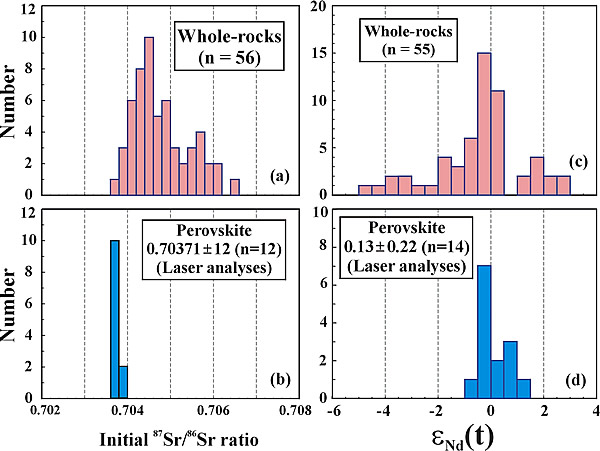Chemical Geology,2009,264:24-42
In situ perovskite Sr–Nd isotopic constraints on the petrogenesis of the Ordovician Mengyin kimberlites in the North China Craton
Yue-Heng Yanga, Fu-Yuan Wua, ,Simon A. Wildeb, Xiao-Ming Liuc, Yan-Bin Zhanga, Lie-Wen Xiea and Jin-Hui Yanga
Abstract

Precise Sr, Nd and Hf isotopic data are important indicators in deciphering the evolution of magmatic rocks and their source. However, such data are difficult to obtain for kimberlite, since these rocks are commonly contaminated by both crustal and mantle materials and also show extensive alteration and weathering following emplacement. In this study, numerous kimberlitic samples from Mengyin in northeast China were selected for U–Pb dating and Sr–Nd–Hf isotopic analysis of perovskite. In situ U–Pb analyses of fresh perovskite yield an age of 470 ± 4 Ma, which is considered the emplacement age of the Mengyin kimberlite. However, the altered perovskite shows Pb loss and yields Paleozoic-Mesozoic ages, indicating that perovskite is not as strongly resistant to isotopic modification as previously thought. In situ Sr–Nd isotopic analyses by laser ablation of perovskite grains collected from the main Mengyin kimberlite record uniform Sr and Nd isotopic compositions with an average initial 87Sr/86Sr ratio of 0.70371 ± 12 and εNd(t) value of 0.13 ± 0.22, which are identical, within uncertainties, to the values obtained by solution analyses. However, they are significantly different from comparable data obtained from whole rock samples, indicating that initial Sr–Nd isotopic ratios calculated from whole rock measurements on kimberlites are likely to record mixed isotopic signatures, due to crustal contamination and/or subsequent alteration. This conclusion is also supported by the Hf isotopic data for perovskite. Meaningful isotopic ratios for kimberlite can therefore only be obtained from single minerals such as pervoskite. The Mengyin samples investigated in this study have isotopic compositions similar to the Group I kimberlite, as defined in Southern Africa, and are interpreted to reflect derivation from a primitive mantle source. Combined with the fact that the Mengyin kimberlites were emplaced coevally with regional lithospheric uplift in the Ordovician at 470 Ma, it is proposed that a mantle plume triggered kimberlite magmatism in this part of the North China Craton.